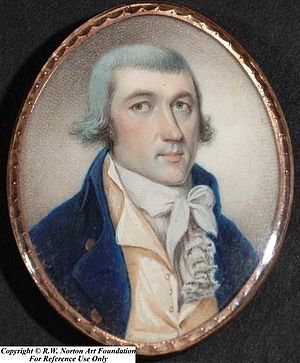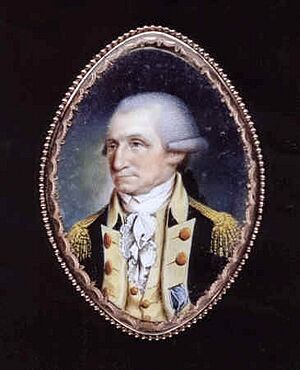John Ramage (artist) facts for kids
Quick facts for kids
John Ramage
|
|
|---|---|

John Ramage, self-portrait
|
|
| Born | 1748 Dublin, Ireland
|
| Died | 24 October 1802 |
John Ramage (born in 1748 – died in 1802) was an artist from Ireland who moved to America. He was also a goldsmith and a soldier. Ramage is most famous for painting tiny, detailed pictures called portrait miniatures. He was the first artist to paint a portrait of George Washington after Washington became the first President of the United States.
Contents
John Ramage's Early Life and Training
John Ramage was born in Dublin, Ireland. In 1763, he joined the Dublin Society of Artists. This is where he started his career as a goldsmith (someone who works with gold) and an artist who painted miniatures.
In 1772, John moved to Halifax, Nova Scotia. He later moved to Boston in the Massachusetts Bay Colony. In Boston, he painted miniatures on ivory, which was a very popular style of portrait at that time.
Ramage During the American Revolution
In December 1775, Ramage joined a military group called "the Loyal Irish Volunteers." This group defended Boston for the British The Crown. He married Victoria Ball in March 1776.
During the Siege of Boston, Ramage and other soldiers loyal to Britain left Boston and went back to Halifax, Nova Scotia. This was a British stronghold. Ramage left Victoria Ball behind in Boston. In Halifax, he married another woman known only as "Mrs Taylor." They had two children together. Victoria Ball later followed him to Halifax to get a divorce.
In June 1777, Ramage left Halifax and moved to New York City. He became a second lieutenant in the City Militia there. He also joined St. John's Masonic Lodge. In January 1787, he married for a third time to Catharine Collins. They had three children together.
John Ramage's Artistic Career
After working as a second lieutenant, Ramage decided to focus on painting miniatures in New York. Even though the art community was small, he became known as the best artist in the city.
He painted many miniature portraits of people in New York. Because he was so skilled, Martha Washington, the wife of George Washington, chose Ramage to paint the first President of the United States. This was a very important job!
The painting session happened on October 3, 1789. It might have taken place at Washington's official home, the Samuel Osgood House, in New York City. Both Ramage and Washington were dressed very nicely for the occasion. Ramage created two different miniature portraits of Washington.
How Ramage Created His Miniatures
Ramage made his miniatures in an oval shape, using ivory and gold. For the ivory parts, he used tiny, delicate lines that crossed over each other. He also used smooth, fine strokes to shape the faces of the people he painted.
For the gold parts, he used decorative patterns like loops and small dots. He also used chased scallops, which are wavy, shell-like designs. For his portrait of George Washington, Ramage even included a lock of Washington's hair with a carefully cut "GW" (for George Washington) design.
Later Life and Challenges
When the British left New York, it might have made things harder for Ramage's business. In 1794, he was having money problems. To avoid going to jail for his debts, he moved to Montreal in 1794.
On his way to Montreal, he got a fever and almost drowned. He had planned to go to Quebec to meet some old friends. But when he reached Montreal, he was very sick.
He arrived in Lower Canada during a time when there was some political tension. After five weeks of getting better from his fever, he ended up in jail. He was released after a month because the grand jury supported his loyalty during the American Revolution.
Even though he was out of jail, Ramage was still unhappy with the Montreal government in 1795. He also said he painted many pictures that year but was only paid for two. In 1796, he wrote that he had done "Some very Extraordinary pictures Lately Sutch as was never Seen in Montreal before."
In 1797, he wrote about how much he missed his family. He said, "Want of money has been the only thing that has Prevented me from flying to your Arms." He also mentioned that he had not been healthy for long periods since coming to Montreal. John Ramage died in Montreal on October 24, 1802. It's possible his death was related to the fever he caught on his journey there.
John Ramage's Legacy
In Montreal, Ramage did not have many friends because he had been unhappy with the people there. Only a few church officials signed his burial record.
Before he died, Ramage asked for land in February 1802. He was given 700 acres of land in Kilkenny Township. The town was built 30 years later, but by then, Ramage's land grant was forgotten.
A famous artist from that time, William R. Dunlap, said that Ramage was "the best artist in his branch in America." This shows how talented John Ramage was, especially with his miniature portraits.
Images for kids




